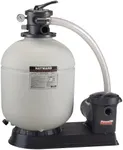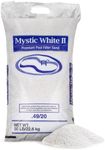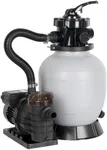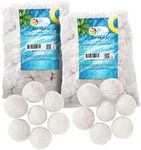Buying Guide for the Best Hayward Pool Sand Filters
Choosing the right pool sand filter is crucial for maintaining clean and clear water in your swimming pool. A sand filter works by filtering out debris and contaminants from the pool water, ensuring a safe and enjoyable swimming experience. When selecting a pool sand filter, it's important to consider several key specifications to ensure you get the best fit for your pool's needs. Understanding these specifications will help you make an informed decision and keep your pool in top condition.Filter SizeThe filter size refers to the diameter of the filter tank and is a critical factor in determining the filter's capacity to handle the volume of water in your pool. A larger filter size can handle more water and filter it more efficiently, which is important for larger pools. For small to medium-sized pools, a filter with a diameter of 16 to 20 inches is usually sufficient. For larger pools, you may need a filter with a diameter of 24 inches or more. To pick the right size, consider the volume of your pool and the flow rate of your pump. A good rule of thumb is to choose a filter that can handle at least the same flow rate as your pump.
Flow RateThe flow rate is the amount of water that can pass through the filter in a given time, usually measured in gallons per minute (GPM). This specification is important because it determines how quickly your pool water can be filtered. A higher flow rate means faster filtration, which is beneficial for larger pools or pools that are used frequently. For small pools, a flow rate of 30-50 GPM may be adequate, while larger pools may require a flow rate of 60-100 GPM or more. To choose the right flow rate, match it with your pool pump's flow rate to ensure efficient filtration.
Filter MediaThe filter media is the material inside the filter tank that traps debris and contaminants. In sand filters, the media is typically high-grade silica sand. The quality and type of sand used can affect the filter's performance. Standard pool filter sand is effective for most pools, but for finer filtration, you might consider using a sand alternative like zeolite or glass media. These alternatives can filter out smaller particles and may last longer than traditional sand. Choose the filter media based on the level of filtration you need and the maintenance requirements you are willing to handle.
Valve TypeThe valve type on a sand filter controls the flow of water through the filter and allows you to perform various functions like backwashing, rinsing, and draining. The most common types are multiport valves and slide valves. Multiport valves offer more functionality and are easier to use, making them a popular choice for most pool owners. Slide valves are simpler and may be more durable but offer fewer functions. Consider how often you will need to perform maintenance tasks and choose a valve type that offers the convenience and features you need.
Durability and MaterialThe durability and material of the filter tank are important for ensuring the longevity and reliability of your sand filter. Most filter tanks are made from high-density polyethylene or fiberglass, both of which are resistant to corrosion and UV damage. Polyethylene tanks are generally more affordable and provide good durability, while fiberglass tanks are more robust and can withstand higher pressures. Choose a filter with a tank material that suits your pool environment and expected usage to ensure it lasts for many years.
Ease of MaintenanceEase of maintenance is a key consideration when choosing a pool sand filter. Regular maintenance tasks include backwashing the filter, replacing the sand, and cleaning the filter components. Look for filters with user-friendly features like easy-access lids, clear instructions, and simple valve operations. Filters that are easier to maintain will save you time and effort in the long run, ensuring that your pool stays clean with minimal hassle. Consider your willingness and ability to perform maintenance tasks when selecting a filter.
















